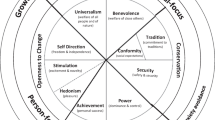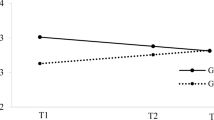Abstract
The present study is a two-wave longitudinal study of the concurrent and prospective associations between patterns of same- and other-gender liking and well-being in a sample of 403 fifth and sixth-grade girls and boys from Montréal Québec, Canada that was used to examine Sandra Bem’s perspective that androgyny is related to well-being. In our study androgyny was operationally defined as (a) the combination of liking for same- and other-gender peers and (b) the combination of being liked by same- and other-gender peers. Well-being was indexed with a measure of the self-concept. Findings drawn from analyses conducted with structural equation modeling showed that androgynous liking was an antecedent and a consequence of well-being. Specifically (a) Time 1 (T1) well-being was a predictor of how much girls and boys liked same-gender and other-gender peers at Time 2 (T2) whereas T2 well-being was predicted by how much girls and boys liked same- and other-gender peers at T1 and (b) T2 well-being was predicted by how much girls and boys were liked by same-gender and other-gender peers. These findings are discussed according to the dynamics of experiences with peers from one’s own gender and the other-gender.


Similar content being viewed by others
References
Bem, S. L. (1974). The measurement of psychological androgyny. Journal of Consulting and Clinical Psychology, 42, 155–162. doi:10.1037/h0036215.
Bem, S. L. (1977). On the utility of alternative procedures for assessing psychological androgyny. Journal of Consulting and Clinical Psychology, 45(2), 196–205. doi:10.1037/0022-006X.45.2.196.
Bem, S. L. (1979). Theory and measurement of androgyny: A reply to the Pedhazur-Tetenbaum and Locksley-Colten critiques. Journal of Personality and Social Psychology, 37, 1047–1054. doi:10.1037/0022-3514.37.6.1047.
Bem, S. L. (1985). Androgyny and gender schema theory: A conceptual and empirical integration. In T. B. Sonderegger (Ed.), Nebraska symposium on motivation 1984: Psychology and gender (Vol. 32, pp. 179–226). Lincoln: University of Nebraska Press.
Bem, S. L., & Lewis, S. A. (1975). Sex role adaptability: One consequence of psychological androgyny. Journal of Personality and Social Psychology, 31(4), 634-643. doi:10.1037/h0077098.
Bukowski, W. M., & Hoza, B. (1989). Popularity and friendship: Issues in theory, measurement, and outcomes. In T. Berndt & G. Ladd (Eds.), Peer relations in child development (pp. 15–45). New York: Wiley.
Bukowski, W. M., Gauze, C., Hoza, B., & Newcomb, A. F. (1993). Differences and consistency between same-sex and other-sex peer relationships during early adolescence. Developmental Psychology, 29(2), 255–263. doi:10.1037/0012-1649.29.2.255.
Bukowski, W. M., Sippola, L. K., & Hoza, B. (1999). Same and other: Interdependency between participation in same-and other-sex friendships. Journal of Youth and Adolescence, 28(4), 439–459. doi:10.1023/A:1021664923911.
Bukowski, W. M., Cillessen, A. H. N., & Velasquez, A. M. (2012). The use of peer ratings in developmental research. In B. Laursen, T. Little, & N. Card (Eds.), Handbook of developmental research methods (pp. 211–228). New York: Guilford.
Chen, S. X., Benet‐Martínez, V., & Harris Bond, M. (2008). Bicultural identity, bilingualism, and psychological adjustment in multicultural societies: Immigration‐based and globalization‐based acculturation. Journal of Personality, 76(4), 803–838. doi:10.1111/j.1467-6494.2008.00505.x.
Cillessen, A. H. N., Bukowski, W. M., & Haselager, G. J. T. (2000). Stability of dimensions and types of sociometric status. In A. H. N. Cillessen & W. M. Bukowski (Eds.), Recent advances in the study and measurement of acceptance and rejection in the peer system. New directions for child development (Vol. 88, pp. 75–94). San Francisco: Jossey Bass.
Daniels, E., & Leaper, C. (2006). A longitudinal investigation of sport participation, peer acceptance, and self-esteem among adolescent girls and boys. Sex Roles, 55(11–12), 875–880. doi:10.1007/s11199-006-9138-4.
Deutsch, C. J., & Gilbert, L. A. (1976). Sex role stereotypes: Effect on perceptions of self and others and on personal adjustment. Journal of Counseling Psychology, 23(4), 373–379. doi:10.1037/0022-0167.23.4.373.
Egan, S. K., & Perry, D. G. (2001). Gender identity: A multidimensional analysis with implications for psychosocial adjustment. Developmental Psychology, 37(4), 451–463. doi:10.1037/0012-1649.37.4.451.
Fabes, R. A., Martin, C. L., & Hanish, L. D. (2004). The next 50 years: Considering gender as a context for understanding young children’s peer relationships. Merrill-Palmer Quarterly, 50(3), 260–273. doi:10.1353/mpq.2004.0017.
Furman, W., & Buhrmester, D. (1992). Age and sex differences in perceptions of networks of personal relationships. Child Development, 63(1), 103–115. doi:10.2307/1130905.
Harter, S. (1982). The perceived competence scale for children. Child Development, 53, 87–97. doi:10.2307/1129640.
Heilbrun, A. B. (1976). Measurement of masculine and feminine sex role identities as independent dimensions. Journal of Consulting and Clinical Psychology, 44(2), 183–190. doi:10.1037/0022-006X.44.2.183.
Heilbrun, A. B., & Schwartz, H. L. (1982). Sex-gender differences in level of androgyny. Sex Roles, 8(2), 201–214. doi:10.1007/BF00287923.
Jones, W. H., Chernovetz, M. E., & Hansson, R. O. (1978). The enigma of androgyny: Differential implications for males and females? Journal of Consulting and Clinical Psychology, 46(2), 298–313. doi:10.1037/0022-006X.46.2.298.
Kark, R., Waismel-Manor, R., & Shamir, B. (2012). Does valuing androgyny and femininity lead to a female advantage? The relationship between gender-role, transformational leadership and identification. The Leadership Quarterly, 23, 620–640. doi:10.1016/j.leaqua.2011.12.012.
La Freniere, P., Strayer, F. F., & Gauthier, R. (1984). The emergence of same-sex affiliative preferences among preschool peers: A developmental/ethological perspective. Child Development, 55, 1958–1965. doi:10.2307/1129942.
Leaper, C. (2015). Gender and social-cognitive development. In R. M. Lerner, L. S. Liben, & U. Muller (Eds.), Handbook of child psychology and developmental science (7th ed., Vol. 2, pp. 806–853). New York: Wiley.
Lee, A. G., & Scheurer, V. L. (1983). Psychological androgyny and aspects of self-image in women and men. Sex Roles, 9, 289–306. doi:10.1007/BF00289665.
Lenney, E. (1991). Sex roles: The measurement of masculinity, femininity, and androgyny. In J. P. Robinson, P. R. Shaver, & L. S. Wrightsman (Eds.), Measures of personality and social psychological attitudes (Vol. 1, pp. 573–660). San Diego: Academic.
Little, T. D. (2013). Longitudinal structural equation modeling. New York: Guilford Press.
Locksley, A., & Colten, M. E. (1979). Psychological androgyny: A case of mistaken identity? Journal of Personality and Social Psychology, 37, 1017–1031. doi:10.1037/0022-3514.37.6.1017.
Maccoby, E. E. (1988). Gender as a social category. Developmental Psychology, 24(6), 755–765. doi:10.1037/0012-1649.24.6.755.
Maccoby, E. E. (1998). The two sexes: Growing up apart, coming together. Cambridge: Harvard University Press.
Markstrom-Adams, C. (1989). Androgyny and its relation to adolescent psychosocial well-being: A review of the literature. Sex Roles, 21(5–6), 325–340. doi:10.1007/BF00289595.
Martin, C. L., & Fabes, R. A. (2001). The stability and consequences of young children’s same-sex peer interactions. Developmental Psychology, 37(3), 431–446. doi:10.1037/0012-1649.37.3.431.
Massad, C. M. (1981). Sex role identity and adjustment during adolescence. Child Development, 52, 1290–1298. doi:10.2307/1129518.
Mehta, C. M., & Strough, J. (2009). Sex segregation in friendships and normative contexts across the life span. Developmental Review, 29(3), 201–220. doi:10.1016/j.dr.2009.06.001.
Mehta, C. M., & Strough, J. (2010). Gender segregation and gender-typing in adolescence. Sex Roles, 63(3–4), 251–263. doi:10.1007/s11199-010-9780-8.
Moreno, J. L. (1934). Who shall survive? Beacon: Beacon House.
Muthén, L. K., & Muthén, B. O. (2010). M-Plus user’s guide (6th ed.). Los Angeles: Muthén & Muthén.
Oxford English Dictionary. (1992). Toronto: Oxford University Press.
Pedhazur, E. J., & Tetenbaum, T. J. (1979). Bem sex role inventory: A theoretical and methodological critique. Journal of Personality and Social Psychology, 37, 996–1016. doi:10.1037/0022-3514.37.6.996.
Prakash, J., Kotwal, A. S. M., Ryali, V. S. S. R., Srivastava, K., Bhat, P. S., & Shashikumar, R. (2010). Does androgyny have psychoprotective attributes? A cross-sectional community-based study. Industrial Psychiatry Journal, 19(2), 119–124. doi:10.4103/0972-6748.90343.
Rubin, K. H., Bukowski, W. M., & Parker, J. G. (1998). Peer interactions, relationships and groups. In W. Damon & N. Eisenberg (Eds.), The handbook of child psychology (5th ed., pp. 619–700). New York: Wiley.
Rubin, K. H., Bukowski, W. M., & Parker, J. G. (2006). Peer interactions, relationships and groups. In W. Damon & N. Eisenberg (Eds.), The handbook of child psychology (6th ed., pp. 571–645). New York: Wiley.
Santo, J. B., Bukowski, W. M., Lopez, L. S., Carmago, G., Mayman, S. B., & Adams, R. E. (2013). Factors underlying contextual variations in the structure of the self: Differences related to SES, gender, culture and “majority/“non-majority” status during early adolescence. Journal of Research on Adolescence, 23, 69–80. doi:10.1111/j.1532-7795.2012.00793.x.
Sippola, L. K., Bukowski, W. M., & Noll, R. B. (1997). Dimensions of liking and disliking underlying the same-sex preference in childhood and early adolescence. Merrill-Palmer Quarterly, 43(4), 591–609.
Spence, J. T., Helmreich, R., & Stapp, J. (1975). Ratings of self and peers on sex role attributes and their relation to self-esteem and conceptions of masculinity and femininity. Journal of Personality and Social Psychology, 32, 29–39. doi:10.1037/h0076857.
Sroufe, L. A., Bennett, C., Englund, M., Urban, J., & Shulman, S. (1993). The significance of gender boundaries in preadolescence: Contemporary correlates and antecedents of boundary violation and maintenance. Child Development, 64(2), 455–466. doi:10.1111/j.1467-8624.1993.tb02921.x.
Whitley, B. E. (1983). Sex role orientation and self-esteem: A critical meta-analytic review. Journal of Personality and Social Psychology, 44(4), 765–778. doi:10.1037/0022-3514.44.4.765.
Wylie, R. C. (1974). The self-concept: Theory and research on selected topics (Vol. 1). Lincoln: University of Nebraska Press.
Wylie, R. C. (1979). The self-concept: Theory and research on selected topics (Vol. 2). Lincoln: University of Nebraska Press.
Yeager, D. S., & Krosnick, J. (2011). Does mentioning “some people” and “other people” in a survey question increase the accuracy of adolescents’ self-reports? Developmental Psychology, 47, 1674–1679. doi:10.1037/a0025440.
Acknowledgments
The authors would like to thank the schools, teachers, principals, parents, the participants and all of those who helped with the data collection, especially Mr. Gordon Rosenoff and Ms. Felicia Meyer. This research was made possible by grants from The Social Sciences and Humanities Research Council of Canada and the Fonds de recherche du Québec: Société et culture.
Author information
Authors and Affiliations
Corresponding author
Ethics declarations
The procedures of the study had been reviewed and approved by the institutional review board of the first author’s home institution. Each aspect of this project was conducted in accordance with the ethical principles of relevant scholarly societies including the Society for Research on Child Development (SRCD) and the American Psychological Association.
Rights and permissions
About this article
Cite this article
Bukowski, W.M., Panarello, B. & Santo, J.B. Androgyny in Liking and in Being Liked Are Antecedent to Well-Being in Pre-Adolescent Boys and Girls. Sex Roles 76, 719–730 (2017). https://doi.org/10.1007/s11199-016-0638-6
Published:
Issue Date:
DOI: https://doi.org/10.1007/s11199-016-0638-6




